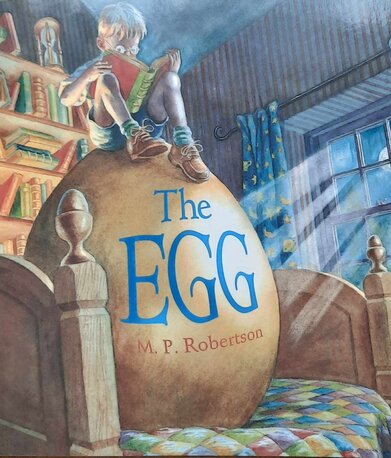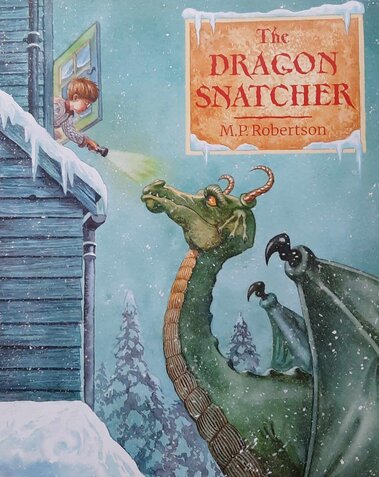Book Review – Dragon Books (Various)

In this excellent article Priestess Elan reviews six children’s books that are all about dragons. Like the best children’s literature, as well as the story line, the books also explore adult themes of caring for the Earth, the values of mothering and not being afraid to be different amongst other things. Enjoy!
In the Cerridwen Kindred, we have a close relationship to the dragons. However, I have an admission to make. My 5 year old daughter probably has a more meaningful relationship with them than I do. I positively encourage this development in her interests. In fact, I find myself looking to her for guidance with the dragons on an almost daily basis. It is not the first time that she has unknowingly delivered a message to me that I have carried in my heart for the rest of that day. Children are often closer to the Otherworld; society passes that off as an interest in ‘fantasy’ and I know that my daughter’s nursery teachers are now a little tired of her continual dragon drawings, hoping that she will choose a different subject to paint or draw! However, looking closer at these drawings that she brings home each week, I see new things in them – colours, moods and symbols emerging from the paper. They are beginning to resemble the cave drawings of the ancestors.
Ruby and the Magic Stones
I am doing my best to encourage her passion for dragons in the books we are reading together, and, having now moved on from Zog, I have been seeking out the more ‘serious’ and mythic dragon books. It began in September of last year, when we picked up Ruby and the Magic Stones by Roseanne B-N and illustrated by Annie B. (Blue Ocean Publishing, 2018) on a trip to Avebury.
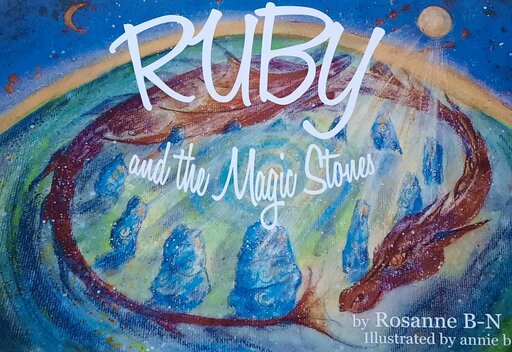
This book has been an excellent way to remember my daughter’s first visit to Avebury because the book centres around this sacred site. In fact, it is a magical origin myth of sorts, with a group of villagers who journey into the Enchanting Woods to seek out the cause of the smoke, which has been threatening their way of life. They find a friendly dragon named Ruby, who has a very bad cold. The friends heal her with herbs and magic and, in turn, she gifts them beautiful crystals from her cave, which they return to their village and plant in the earth. The crystals ‘grow’ to become Avebury stone circle, and Ruby becomes their guardian. This is a beautiful book to introduce the healing power of crystals and guardian spirits of the land.
The Moon Dragons
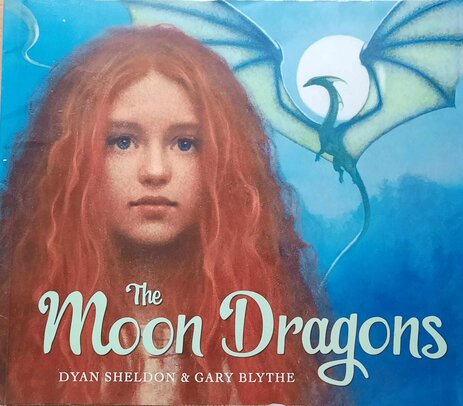
The Moon Dragons by Dyan Sheldon and Gary Blythe (Andersen Press, 2014) is a story which has meaning for children and adults alike, deepening with each read. It has the feel of a fable or folktale. A traveller once told a king a tale – ‘Long ago, when even trees had dreams, moon dragons flew through the night sky. Their scales shone silver as stars and they filled the dark with songs as old as time’. The king believes that all the dragons have been killed but the traveller assures him that some survive, hiding out in the distant mountains. The greedy king summons his huntsmen to go out and find him a moon dragon but all fail in their quest. A young girl called Alina offers to go on the quest for a dragon and she is laughed at by the king and his court. But she is capable and knowledgeable about the land and she makes it to the top of the mountain. In the soft lunar light, she is gifted a sight of the moon dragons. When she returns to the king, she chooses not to tell him what she has witnessed, knowing that the dragons would be exploited and killed. In her pocket is a silver scale – ‘a flight of dragons is worth more than a room full of gold’. I have had a number of conversations with my daughter about the meaning of this; the book is an excellent way to approach the subject of responsibility to the land and all its beings, magical and otherwise, while also introducing her to the concept that not all peoples’ intentions towards beautiful creatures is worthy of the gifts these beings hold.
The Night Dragon
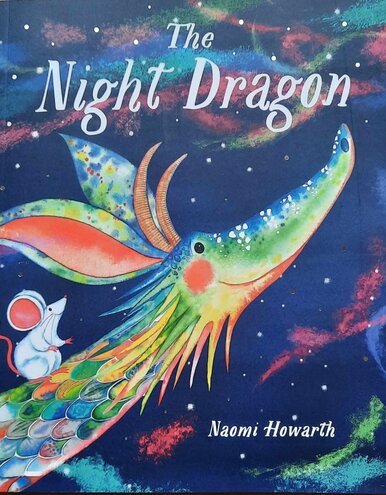
On a similar subject of intention and creativity, The Night Dragon by Naomi Howarth (Frances Lincoln Children’s Books, 2018) is a fun story of a dragon called Maud who is a little bit different from the other dragons. While the dragons who live alongside her bring in night by covering the sun with their sooty breath, Maud is afraid to breathe fire and take to the skies until her friend, Mouse, encourages her to open her rainbow wings. The smoke on her breath is multi-coloured and she soars over cities, valleys and rivers, introducing her colourful hues to the sky – ‘so next time you see a colourful sunset, you’ll know that Maud and Mouse are not far away’. This is such an encouraging message for children to be themselves in a world which at times may feel quite restrictive and daunting to them.
The Egg
The next two books by M.P. Robertson – The Egg (Frances Lincoln Children’s Books, 2000) and The Dragon Snatcher (Frances Lincoln Children’s Books, 2009) are part of a series of books following the relationship between George and ‘his’ dragon, which hatches from a golden egg that George finds in his mother’s hen coup. These books promote the idea of a reciprocal relationship between dragon and child. For example, when the dragon emerges from the egg, on first sight of George, he looks to him for comfort.
This book teaches children that anyone is capable of mothering – ‘George had never been a mother before, but he knew that it was his motherly duty to teach the dragon dragony ways.’ He is rewarded for this by being invited to visit the world of the dragons, in ‘a place that was neither North nor South, East nor West’.
Likewise, in the second book, when George and his dragon save a dragon egg from an Ice Wizard, the dragon which hatches from the egg attaches himself to the wizard (‘“He thinks you’re his mother”, said George’), and the Ice Wizard’s heart melts. Perhaps this is a lesson for myself – to be more open, and approach dragons with the heart of a child.
Tell Me a Dragon

Finally, we have recently acquired a book which has enchanted and captured our imaginations in the most beautiful of ways. Tell Me a Dragon by Jackie Morris (Graffeg Ltd, 2018) is as much a coffee table art book as it is a children’s book. Jackie Morris is the illustrator of The Lost Words books so her artwork is predictably breathtaking. Daniel Hahn (The Ultimate Book Guide) writes that ‘Tell Me a Dragon shows you what picture books can be at their most elegant and lyrical – if you can’t get a dragon of your own, well, this magical book may be the next best thing’.
Each page describes a different sort of dragon – there are elemental dragons, city dragons and tiny dragons that whisper wisdom and song in your ear. Our favourite dragon changes on a daily basis but ‘My dragon eats sweet perfumed flowers. When she laughs, petals ride on her breath’ takes some beating! There are pages at the back which give more information about dragons, spells, and the collective nouns for dragons (a Blaze, a Flight, a Weyr, a Wing, or a Dreaming). Morris also encourages readers to ‘tell their own dragon’, and I have started a little notebook of my daughter’s descriptions of her own dragons. Last night she fell asleep describing her ‘dream dragon’… dragons that flit through our dreams and visions – what more can we ask for?
Blessed Be
Elan, Priestess of Cerridwen
West Lothian, Scotland
![In this season of Water on Cerridwen’s Wheel of the Year, we have reached the point when summer is properly upon us; many people are turning to the thought of holidays and others are gearing up for music festivals across the country. This is the time when ‘going with the flow’ seems like a good plan! Hard work can wait for a while – perhaps ‘messing about on boats’ on the river as the Water Rat said to the Mole really is the answer. As I explore the folk song tradition through the lens of Cerridwen of Water, I am thinking of a concept, which has its source in the symbolism of water and which never fails to inspire and move me – that of the Carrying Stream. The Carrying Stream comes from a poem, composed by the Scottish folk collector, ethnologist and poet, Hamish Henderson. Should there be a name and credit here? These are words from an elegy, which he wrote for himself: Change elegy into hymn, remake it – Don’t fail again. Like the potent Sap in these branches, once bare, and now brimming With routh of green leavery, Remake it, and renew. Maker, ye maun sing them … Tomorrow, songs Will flow free again, and new voices Be borne on the carrying stream. This Carrying Stream has come to mean being part of the passing on of a tradition, mainly through music and culture. Henderson, who was one of the first folk collectors in the School of Scottish Studies in Edinburgh (a treasure house of tradition and the ‘voice of the people’ established in 1952 in George Square, at the University of Edinburgh). He knew the value of song and tradition and he travelled all over Scotland, collecting songs and stories from the people he met. He is well-known for the relationships he formed with the Traveller communities – those who were ‘Summer Walkers’ and the berry pickers of Blairgowrie. It is significant that it was often the Travelling community who were the best source of knowledge for the ‘old songs’. These people were often shunned and derided and yet it was their characteristic movement across the land (the reason for many peoples’ distrust of them) that enabled them to pick up songs from many places and carry them forward. Henderson’s ‘discovery’ of the ballad singer, Jeannie Robertson was described by Henderson as ‘the most important, single achievement of my life – the thing of which I am most proud.’ Should there me a name and credit here? She was a Traveller with a vast storehouse of traditional knowledge and song. In 1941, in Poetry and Prophecy, the archaeologist N.K. Chadwick had written that ‘among the early Celtic peoples the inculcations of poetic inspiration and the mantric art were developed and elaborated to a degree for which we know no parallel.’ Hamish Henderson believed that Jeannie Robertson was evidence that that tradition continued. Interestingly, Jeannie spoke about her ballad knowledge in the same way we often think of the learning of the Druids – through word of mouth. My Ballads? I learned them from my mother. I never learned them through books – some had been on paper – they were never learned off a paper. That’s certain. But they went from mouth to mouth in their day – the old songs – as my mother said to me. I said to her one day, ‘how did you come to learn your songs?’ ‘Well lassie,’ she says ‘I learned my songs the same way,’ she says ‘as you’re learning them’ she says ‘from me’. I learned them off my mother. The ballads… I’m singing a story when I sing a ballad – and most of them is really history. When I’m singing the song, tae tell ye the God’s truth, I picture it – just as it wis really happening. This quotation is so rich in wisdom! Jeannie Robertson perfectly describes the attributes of the Carrying Stream (and the lineage of the motherline is also interesting in this context). In her description of her process, she shows how the tradition is essentially a generous one. It has to be, or it would not survive. Thus, the songs are passed on through the generations… the river flows on. She also reveals how these songs exist for her in a sort of eternal present, with history and myth intermingling. For those of us with more than a passing interest in the story of the Goddess Cerridwen, we know how easily the eternal present works in the mouths of the Bards. Cerridwen’s story is as fresh now as it was centuries ago because it has been passed on through poetry and song. We can relate to the emotions and the events in Her story just as readily as our ancestors would have done. Hamish Henderson believed that the folk song tradition was a democratic one. Anyone can sing a song and share it with others. No one has ownership of it or takes precedence over another in this process. And, like a stream or a fast-flowing river, the song will pick up many flavours and characteristics of the places and people that it passes through. Nothing is intransigent. Everything can change and flow forward with the movement of the water. This is one reason why the folk collectors in the British Isles often found many different versions of one song. Words were changed and altered to suit different locations but, most often, the real meaning of the song remained. In other instances, new verses would be added to a song. People were not afraid to create something new from an older tradition. In our Cerridwen tradition, we practice something very similar. Our own Cerridwen song, which was first brought into being by Priestess Zindra Andersson at a Dark Moon Ritual, is added to each year – each Spiral of initiated Priest-esses compose a new verse, and so the Carrying Stream of Cerridwen’s inspiration flows on. Mother of the Darkness Mother of the Darkness, Hear our song, Mother of the Darkness, Hear our song. Take us to your cauldron, hold us when we die within. Show us what we need to see, Heal our wounds and set us free. From the darkness we find voice, Help us to accept our choice. From the cauldron we’re reborn, Hear our truth we are transformed. Bless us as we sing to you, shine your light and guide us through. Transformation makes us new, We found our light in you. Mother of the Darkness, Hear our song, Mother of the Darkness, Hear our song. Last month, we held our Avalon Cauldron Gathering in the Assembly Rooms in Glastonbury. [Cerridwen Song Brew and altar. Image Credit: Elan] During our Cerridwen Song Wheel workshop, nine Cerridwen Song Priestesses represented the aspects of the Song Wheel. These Priestesses took on the mantle of Cerridwen’s birds and the magic which was brought through that day was potent. The workshop was the culmination of a year and day (so far!) exploring Cerridwen’s Song Wheel and the part which song and music plays in our understanding of the nature of Cerridwen. She is the Goddess of the Bards and, as the different aspects of the Wheel came through, so too, did the singing of Nature’s Bards – the birds. As each of the nine took their place on the wheel – Robin, Blackbird, Hawk, Wren, Kingfisher, Nightingale, Raven, Heron and Owl – an interesting thing happened. The birds did not always stay in one place. They were quite ‘flighty’, which is perhaps understandable given their nature as creatures of air. Most significantly, another bird – the Lark – often attempted to join the nine. The Lark did this subtly, in slips of my tongue when discussing Cerridwen’s song birds. She would slip in unnoticed as I typed up notes and I would have to correct myself later. I was in no doubt that the nine birds of the Song Wheel were the right ones – I had followed signs, visions and my intuition in this process. But I also pay attention to seemingly innocent mistakes – who was this bird who seemed intent on gatecrashing Cerridwen’s ceilidh? I almost felt a little sorry for the Lark. After all, this bird is a beloved subject in numerous folk songs in Britain and Ireland. For example, ‘The Lark in the Morning’ beautifully describes the habit of the Lark who will sing at the break of day: The lark in the morning she arises from her nest And she ascends all in the air with the dew upon her breast, And with the pretty ploughboy she’ll whistle and she’ll sing, And at night she’ll return to her own nest again. Lark by Dae Jeung Kim Pixabay Larks will sing high up in the air, with their chirrups starting just after they lift off from the ground. Their sustained and complicated songs mesmerise potential mates and strengthen existing bonds between pairs. While reading Andrew Millham’s Singing Like Larks: A Celebration of Birds and Folk Songs, I chanced upon a piece of information which perhaps explains the circling of the Lark around Cerridwen’s Song Wheel: The song of the lark mimics and incorporates songs from other birds… which is no different from folk music. Traditional songs are constantly evolving, merging with each other, and one song can diverge into two entirely different entities, or three, or four! An individual will, perhaps without even thinking, alter a song in melody, rhythm and lyrics to satisfy their own personal artistry. The lark certainly does this too. The rather mischievous appearance of the Lark in the already formed Song Wheel of Cerridwen was perfectly understandable given this fact (and it was further confirmation to me that this intuitive Wheel has a basis in the natural world and holds within it an innate knowledge of the native wildlife of Her landscape). The Lark was simply mimicking the Song Wheel birds as she always does! And, by extension, I realised that the Lark is also a beautiful symbol of the Carrying Stream; like the metaphorical river of folk song, she picks songs up from others, tries them out for size, and changes them accordingly. Like Cerridwen’s rivers of inspiration, which flow through our inner and outer landscapes, we need to move with the currents, change and adapt, so that inspiration (be that in the form of song, poetry or other creative endeavours) remains fresh. Cerridwen is the Goddess of Inspiration and She is also the Goddess of Transformation. The songs of our ancestors – the ‘folk’ in folk songs – are our legacy. They belong to us. They belong to everyone. Like the Goddess who inspired their conception, they are living entities in their own right, which deserve to be honoured and respected. The greatest honour we can give a song is to sing it out into the world and pass it on to new generations. Blessed Be Elan, Priestess of Cerridwen West Lothian, Scotland Instagram: @elan_and_the_hare Elan is a scholar, writer and editor in the field of Celtic Studies. She has a PhD in Gaelic poetry and teaches university classes in Celtic culture and literature.](https://cerridwen.co.uk/wp-content/uploads/2023/06/Priestess-Elan.jpg)
Instagram: @elan_and_the_hare
Elan is a scholar, writer and editor in the field of Celtic Studies. She has a PhD in Gaelic poetry and teaches university classes in Celtic culture and literature.
